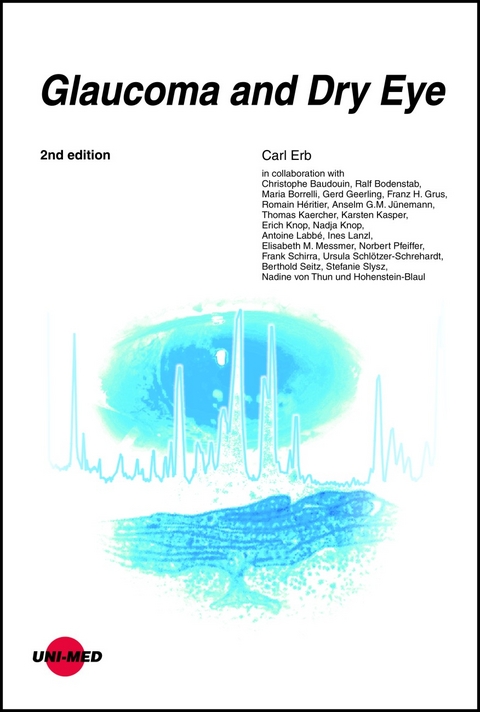
Glaucoma and Dry Eye
UNI-MED (Verlag)
978-3-8374-2405-8 (ISBN)
- Titel ist leider vergriffen;
keine Neuauflage - Artikel merken
1. Fluid mechanics of the tear film (R. Bodenstab) 141.1. Introduction 141.2. Model conceptions 141.3. Basics of numerical tear film models 151.4. Newtonian versus non-Newtonian fluids 161.5. Mucin 161.6. Factors influencing mucin rheology 171.7. Flow behavior and tribology 191.8. Extended model of lubrication 211.9. Influence of tear film on eyelid blink 221.10. References 242. Corneal nerves in glaucoma and dry eye: Contribution of in vivo confocalmicroscopy (A. Labbé, R. Héritier, C. Baudouin) 282.1. Introduction 282.2. Corneal nerves and IVCM 282.3. Corneal nerves and dry eye disease 292.4. Corneal nerves in patients medically treated for glaucoma 312.5. Role of inflammation in corneal nerve alterations in dry eye disease and glaucoma 322.6. Conclusion 322.7. References 323. A clinical overview of dry eye (T. Kaercher) 363.1. The dry eye 373.2. The wet eye 403.3. The inflamed eye 413.4. References 434. Investigation of dry eye (F. Schirra, B. Seitz) 464.1. Introduction 464.2. History 464.3. Findings 464.3.1. Lid parallel conjunctival folds (LIPCOF) 464.3.2. Meibomian gland dysfunction 484.4. Diagnostic tests 494.4.1. Notes on diagnostic tests 494.4.2. Measurement of tear volume 494.4.2.1. Schirmer's test 494.4.2.2. Other tests of volume 524.4.3. Measurement of tear film stability 524.4.4. Integrity of the ocular surface 544.4.4.1. Fluorescein test 544.4.4.2. Rose Bengal test 554.4.5. Measurement of the osmolarity of tear fluid 564.5. References 565. Eye-Associated Lymphoid Tissue (EALT) and its relationship to siccasyndrome (E. Knop, N. Knop) 605.1. Overview of the dry eye 605.1.1. Definition 605.1.2. Symptoms and clinical tests 605.1.3. Epidemiology 605.1.4. The eye´s mucosal immune system is protective - but if deregulated can promote inflammationin dry eye disease 605.2. Anatomy of the ocular surface and mucosal immune system 615.2.1. Structure of the ocular surface and tear film 615.2.2. Mucosal immune system of the ocular surface 625.2.2.1. Components of the mucosal immune system 625.2.2.2. The mucosal immune system of the ocular surface forms continuous eye-associated lymphoidtissue (EALT) 655.3. Influence of the mucosal immune system on dry eye 655.3.1. The normal function of EALT is protective 665.3.2. Deregulation of the mucosal immune system through chronic surface irritation in dry eye canlead to the loss of immune tolerance 665.3.3. The loss of immune tolerance leads to chronic progressive immune-modulated inflammationwith destruction of the ocular surface 685.4. References 696. The importance of autoimmune processes in sicca syndrome and glaucoma(F. Grus) 786.1. Introduction 786.2. Autoimmune processes in glaucoma 786.3. Sicca syndrome: analysis of tear fluid 796.4. Can glaucoma and sicca syndrome now be described as autoimmune diseases? 816.5. Natural autoimmunity 826.6. References 847. Preservatives and their relevance for the ocular surface (G. Geerling,M. Borrelli, K. Kasper) 887.1. Background 887.2. Why are ophthalmics preserved? 887.3. Common preservatives 897.3.1. Quaternary ammonium compounds 897.3.2. Mercury compounds 907.3.3. Alcohols 907.3.4. Sorbic acid 907.3.5. EDTA 917.3.6. Oxychloro complex 917.4. Problems with the use of preservatives 917.5. Preservative-free container forms 927.5.1. Single-dose drop containers 927.5.2. Bottles with innovative valve/pump technologies 947.5.3. Microfilter system 957.6. When should preservative-free artificial tears and antiglaucoma products be used? 957.7. Costs 957.8. Individual therapy, compliance and freedom for medical treatment 967.9. References 968. Results of the German Register for Glaucoma Patients with Dry Eye (C. Erb) 1008.1. Introduction 1008.2. Prevalence of concomitant diseases 1008.3. Gender and age differences 1008.4. Effect of anti-glaucoma agents and duration of glaucoma disease on the prevalence ofdry eye 1008.5. Benzalkonium chloride/anti-glaucoma
| Erscheinungsdatum | 16.05.2020 |
|---|---|
| Reihe/Serie | UNI-MED Science |
| Verlagsort | Bremen |
| Sprache | englisch |
| Maße | 176 x 246 mm |
| Gewicht | 376 g |
| Themenwelt | Medizin / Pharmazie ► Medizinische Fachgebiete ► Augenheilkunde |
| Schlagworte | antiglaucomatous eye drops • Dry eye • glaucoma • neuropathy |
| ISBN-10 | 3-8374-2405-7 / 3837424057 |
| ISBN-13 | 978-3-8374-2405-8 / 9783837424058 |
| Zustand | Neuware |
| Haben Sie eine Frage zum Produkt? |
aus dem Bereich


